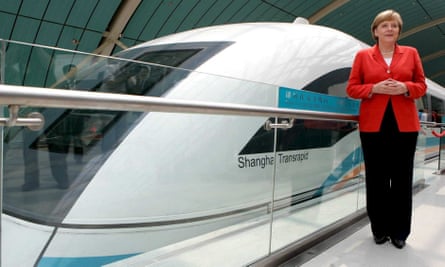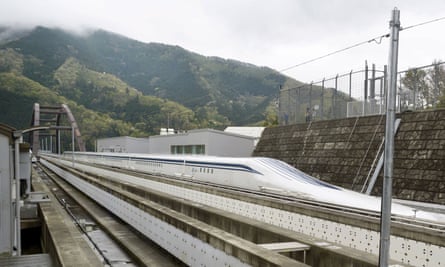Clean, green, quick and quiet; no wheels, no engines to fail; able to stop quickly and safely and glide off noiselessly on a cushion of air.
Magnetic levitation (maglev) was, according to 1980s science shows such as Tomorrow’s World, going to make domestic air travel defunct, humming from city to city at 500mph with negligible effects on the environment (and no need to remove your belt and shoes).
With no wheels and only one track, Maglev trains would pooh-pooh bad weather, the wrong type of leaves on the line, or a points failure at Cricklewood. Because of the way maglev (in various ways) repels the train above its track, derailments are unlikely: the further the vehicle gets from its track, the stronger the magnetic force pushing it back. No signalling or moving parts to go wrong, with all the trains travelling at the same rate. Imagine the effect on commuting and by extension the economy – the Midlands would be half an hour from London.
Amid the traffic jams and pollution, a greener mass transit solution makes sense more than ever.
So why weren’t you able to glide to work at supersonic speeds this morning? The concept has been under development for over a century, with dozens of patents filed since the early 1900s. While there have only been a handful of commercially viable systems built, of which only three – all in Asia – survive today, more are now being tested around the world.
Britain actually ran the world’s first: the Birmingham airport AirLink shuttle that ran from 1984-95. It was popular and cheap to run, but unreliable and expensive to maintain as the one-off components were hard to find.

Germany also blazed a trail in the late 1980s with West Berlin’s M-Bahn, a driverless train on a mile of track with just three stations. But floating trains were put on the backburner and the line was closed with reunification in 1990. The manufacturer, TransRapid, maintained a test facility for the trains until an accident killed 23 in Lathen in 2006.
That would have sealed it for German maglev had TransRapid not already been commissioned to build the Shanghai airport maglev in 2001. This remains the world’s fastest electric train (268mph), and makes the 19-mile, hour-long taxi journey from the airport to Shanghai’s business district in just eight minutes. China also has a medium-to-low speed (about 99mph) maglev line in operation in Changsha, the capital of Hunan province. China likes maglev so much it says it plans to launch services in up to 12 cities by 2020.
There are now several other maglev projects in progress in Asia; the best known perhaps being the unmanned EcoBee shuttle that travels to and from South Korea’s Incheon airport. This shortish line linking seven stations along which the shuttle travels at the comparatively sedate 68mph was completed in 2012. And it’s free: Heathrow Express take note.
Japan’s Linimo line near Nagoya runs a similar urban light rail-style vehicle at relatively low speeds. The Japanese are old hands at maglev, having laboured patiently (and expensively) with the technology since 1969. Their much more ambitious Chuo Shinkansen (central bullet train) maglev line is already under construction and will see trains eat up the 178 miles between Tokyo and Nagoya at 310mph – mostly underground.
It can be done – so why can’t we do it? Why are we ripping up the Cotswolds to allow HS2 to blast noisily through our dwindling countryside when the Japanese will be able to silently tube through 178 miles in under 40 minutes?
Money. If you’re going to build maglev you must do so from scratch. Most governments simply won’t take that hit, especially if standard rail infrastructure is already in place. Shanghai’s comparatively small maglev cost £840m to build, while Japan’s will be around £58bn. The US Federal Railroad Administration has balked at the up to $100m (£70m) per mile it estimates it would cost to build.
Plus, there’s no guarantee of profit, and if that’s your motivation, the political will is unlikely to be forthcoming. Even the successful Asian projects were brought to fruition decades late and at great cost. Japan has been at it for four decades. The Shanghai line has been losing money – some 600-700m yuan (£70m to £82m) a year, in addition to its massively expensive build cost, since it floated in 2004.
The Chinese government may be able to engage in such chest-thumping, but most governments will feel it’s cheaper to upgrade existing railways, unless the cash comes from private sources. But even the much vaunted, ostensibly private Japan Railways Group was for most of its history state-run, and even today is heavily subsidised.

As for Britain, it has been suggested that the UK’s current power profile may mean maglev is uneconomical for long distances – hence no maglev HS2. Yet a state-run, clean, green, cheap rapid transit system should surely be an investment for the future, with big potential savings down the line in lower future maintenance and better reliability.
Incheon’s maglev may have cost £25m per km, but they boast that’s a third of the cost of regular rail, and “while the cost of supplying electricity to a maglev line is 30% greater than for a regular light rail, it costs 60% to 70% less to operate the train.”
Likewise, the Japanese Linimo line may have cost around £70m per km to build, but is proving to be low-maintenance, reliable and quiet compared with traditional transit systems (and ideal for cities, with its zero emissions). In the UK, it was estimated in 2006 that the cost of a maglev track would only have been half that of the Channel tunnel rail link.
We should watch Asia with interest. If nothing else, they are showing that if there’s a political will, there’s a maglev railway.
